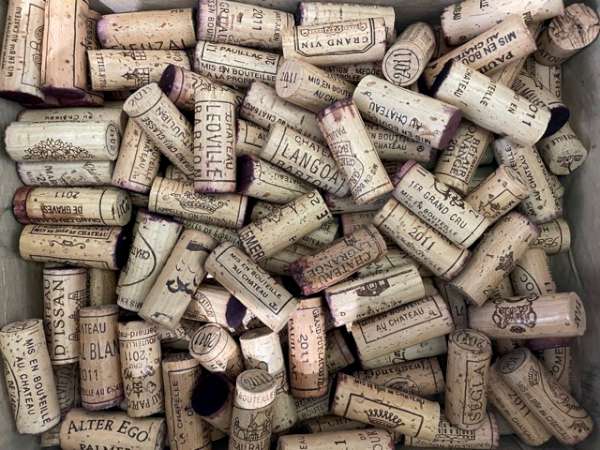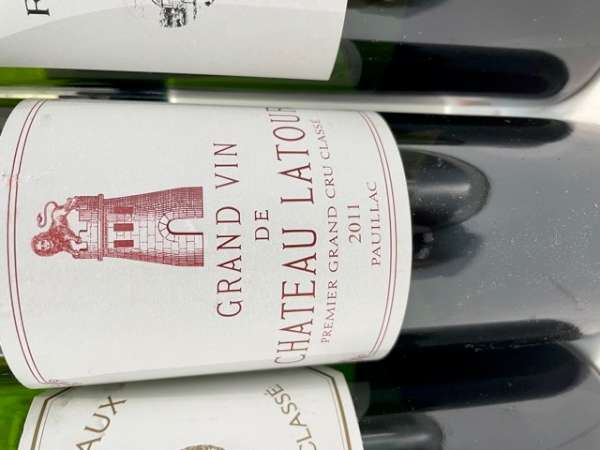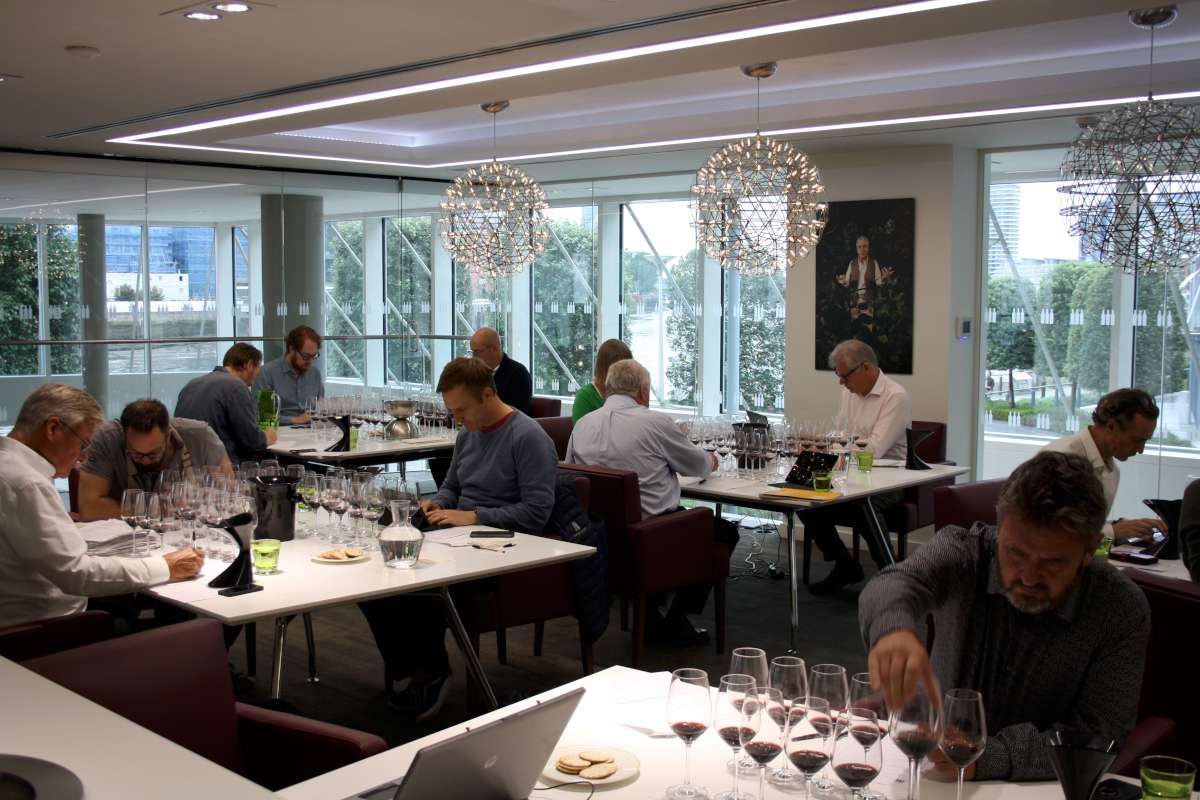
The annual “Ten Years On” blind tasting this year was delayed from February because of the pandemic but eventually took place at the beginning of October 2021 – appropriately exactly ten years after the harvest’s last Cabernet Sauvignon grapes were picked.
Regular readers of these blogs will know that I have been a member of this tasting group for nearly 30 years. The first event that I attended was held in 1992 when we looked at the still youthful 1982 vintage. Ever since then, we have met annually to assess the vintage that is celebrating its tenth birthday. Over the years the tasting has had various homes but in recent times it has taken place in Farr Vintners’ magnificent tasting room in Battersea overlooking the River Thames. My son Ben organises it these days and does a superb job in collating nearly 150 bottles from the leading châteaux of Bordeaux and serving them – strictly blind! – in peer group flights of 12. In each flight we know which wines are to be served but not the order - which is completely random.
So, this year it was the turn of the 2011 vintage to be scrutinised by our experienced group which included wine writers Neal Martin (of Vinous), Mark Andrew MW (of Noble Rot) and Jancis Robinson OBE MW. The group contains 7 Masters of Wine and the wine buyers of the most respected UK Wine Merchants.

Of course, we first tasted 2011 en primeur (from barrel) in the Spring of 2012 and then again in a mammoth blind tasting at Southwold (from bottle) in January 2015. Our first impressions of the vintage were – to be honest – not great. I described it as “unexciting” in my report that you can read here - I think I was being diplomatic with that description as I remember it being a really hard slog. Not only did the vintage suffer from following two absolute classic years (2009 and 2010) meaning the wines were less good, they were also ferociously tannic and hard to enjoy in their youth. Simply put: they were no fun and we came away from the first tasting with very little affection for 2011. Impressions were that it was tannic and lean with too much structure for the fruit. In other words, more bone than flesh. To make matters worse, it was over-priced on release and our customers didn’t see a profit on their investments - so you can certainly see why 2011 became the “unloved” vintage for us in the wine trade. However, in the last couple of years many people (myself included) have had some very pleasant surprises as some of the wines appear to have shaken off their cloaks of tannin and blossomed into attractive mature clarets. The rumours were that the ugly duckling had turned into a swan. Was that wishful thinking? Or was it true? There was only one way to find out....
Our two day tasting kicked off, as usual on the right bank. We like to throw in a few examples from less fashionable appellations and the first flight produced one of the biggest surprises of the whole tasting with victory (over several well-known St Emilions and Pomerols) for Château Joanin Bécot from Castillon. Not only is this a humble name but this was also the cheapest wine that was served over the event. Currently available at £165 per dozen from Farr Vintners, we were impressed by the intensity of sweet black fruit here and the well-rounded tannins that give it structure and balance. A very impressive achievement from this bargain of the vintage.
Then we moved on to some of the bigger names of St Emilion. This was a really mixed bag and overall it was the most disappointing flight of the tasting. One must remember that, when these wines were made, the uber-critic Robert Parker was at the height of his fame and it seems to me that too many properties decided to concentrate their wine in an attempt to appeal to Baltimore Bob and his magic 100 point scale. This was a mistake in my opinion – especially in this vintage. One big name was oxidised and several others seemed artificially ripe with ruthlessly dry, papery tannins. I think that a lot of the over-extractors learned a valuable lesson in 2011 and winemakers started to use a lighter touch in subsequent vintages. The best performers were Ausone, Tertre Rôteboeuf, Bélair Monange and my own two favourites Figeac and Cheval Blanc.
On to Pomerol where the wines showed much better than their right bank neighbours. More flesh, softer tannins and less obtrusive winemaking. Of the top scoring wines on the right bank at the end of the day, five out of the top six were Pomerols. Once again, there was a great showing by L’Eglise Clinet (rated just above Pétrus and just below Lafleur) but our top two Pomerols this year were from the same family – the Thienponts – whose Vieux Château Certan and Le Pin were both excellent. This was a repeat of the Southwold result where the same two châteaux were victorious. Special praise should also go to a lovely La Conseillante that was not far behind. If you have extremely deep pockets then buy Le Pin, but VCC and La Conseillante still offer excellent value if you can find them.

Then it was across the Dordogne and the Garonne to Péssac-Leognan. Leaving aside the excellent Haut Brion and La Mission (which I will talk about later), our top scorer was Smith Haut Lafitte which again was a repeat victory from the original Southwold tasting. This is a wine of lovely balance – nicely spicy but cool and composed. Not too rich and not too dry. Nicely done and a worthy winner even if it’s not one of the greatest wines of the vintage.
Into the Médoc we go and let’s talk about the commune of Margaux first. There were really no surprises here at all with Margaux, Palmer, Rauzan Ségla and Brane Cantenac taking the top 4 spots with quite a gap to 5th place. Château Margaux itself was the best (of course) but Rauzan Ségla and Brane Cantenac tied in a dead heat for second place with Palmer a whisker behind. These wines were all good but they weren’t absolutely great so we hoped for better things further up the Médoc.
We didn’t have long to wait as the wines of St Julien really came up trumps. This was the best performing commune of the entire tasting with some really excellent efforts – not just in the context of the vintage but there are some genuinely good, ready-to-drink, clarets here. Last time round Léoville Poyferré was the winner and this time it was only narrowly pipped to the post by the impressive Ducru Beaucaillou – a wine with big, bold black cassis fruit: serious, deep and refined. Léovilles Lascases and Barton were only just behind them, but putting these superstar 2nd growths to one side for a moment, there was a fabulous performance by Langoa Barton which – at one third of the price of Ducru and Lascases – could be seen as the people’s champion! Funnily enough I had a bottle of it with my wife Sophie (a harsh critic I can assure you) just last weekend and she absolutely loved it. My advice is to “fill your boots” here. This is a mature, classic claret with ten years of good drinking ahead that gives brilliant value for money at £420 per dozen excl. taxes. It’s hard to think of a better Bordeaux deal than this.
Moving up to Pauillac we again found that despite the tasting being completely blind the wines that we might have expected to perform best did so with ease. Amongst the First Growths the group’s absolute favourite (by a comfortable margin I might add) was Château Latour. There was no disputing that this is the wine of the vintage. Happy news for my family as Ben Browett and Thomas Parker picked the grapes ten years ago during their University summer vacation. You can read a series of blogs by the boys on this site, including this one. Anyway, back to the tasting and Latour was our overall winner. I loved Mouton too which had a wonderful nose of smoky bonfires and a cassis infused palate. (These were our top two First Growths but Haut Brion came close behind with Margaux next). However, the big story in Pauillac was the magnificent performance of Pichon Baron which came second overall and fooled us all into thinking that it had jumped from Second Growth to First. Looking at my notes, this was no fluke as apparently it "romped home" last time round as well. This is basically a wine that tastes like a First Growth in 2011 and if you can find some (and can afford it) then just buy it! It’s great. There were also really excellent performances by Pichon Lalande and Lynch Bages. However, special mention must go to Haut Batailley as the highest scorer in Pauillac outside the 1st and 2nd Growths and - at less than £30 per bottle - this wine offers brilliant value for money. If you’re looking for a mature Pauillac that won’t break the bank then this is one. If it had been served again in the Saint Estèphe flight it would have won it!
And so to Saint Estèphe for the last of the reds This is a commune where the wines usually need a really ripe vintage to shine – think of the great successes here in 2003 and 2009. 2011 is clearly not a major success here, but this village did provide the only real shock result of the tasting. With everyone expecting the “big two” of Cos d’Estournel and Montrose to walk it to the winners’ podium, the huge surprise was that the top two wines turned out to be – drum roll please – Lafon Rochet and Les Ormes de Pez. At £240 per dozen Les Ormes de Pez gives absolutely amazing value for money and Farr Vintners has wasted no time in buying all the remaining stock in Bordeaux that we could find.

Finally a word about Sauternes. Unfashionable they may be, but this is really a very good vintage for the sweet wines of Bordeaux. Once again (and despite being served blind amongst 2 dozen other wines) well done to Yquem for coming out in pole position. Other top performers were Rieussec, Doisy Daene and La Tour Blanche. And if you’d like an insider tip, a certain critic gave their highest score of the entire tasting to the gorgeous Suduiraut. We are pleased to be able to offer it to Sauternes lovers today in bottles and halves at well below the original release price!
So, what are our conclusions? Well: it’s not a great vintage, we knew that already. But the best wines (which are mainly from Saint Julien and Pauillac) have filled out nicely with time in the bottle. They are “proper” clarets with good structure and dry cassis fruit and the great thing is that they are ready to drink now but will remain so for at last a decade at the top end. Where does the vintage figure in the scale of recent years that we have tasted? It’s certainly better than 2013 and it is comparable to 2017. Our next “Ten Years On” tasting will be 2012 and I expect those wines to be a bit more supple and friendly – and certainly better than 2011 on the right bank.

In a nutshell, this is a “difficult vintage” rather than an “off-vintage”. It is by no means uniform in quality but the best wines – as identified in our blind tasting – make surprisingly good glasses of proper mature claret. If you are looking for value then the likes of Langoa Barton, Haut Batailley and Les Ormes de Pez are my top picks. If you want simply the best then it’s Latour and Le Pin for you, but for First Growth quality without a First Growth price then it’s got to be Vieux Château Certan, La Conseillante, Ducru Beaucaillou, all 3 Léovilles, Pichon Baron, Pichon Lalande and Lynch Bages.

A discussion amongst the group at the end of the tasting came up with this ranking of recent years (we have yet to blind-taste 2018, 2019 and 2020)
